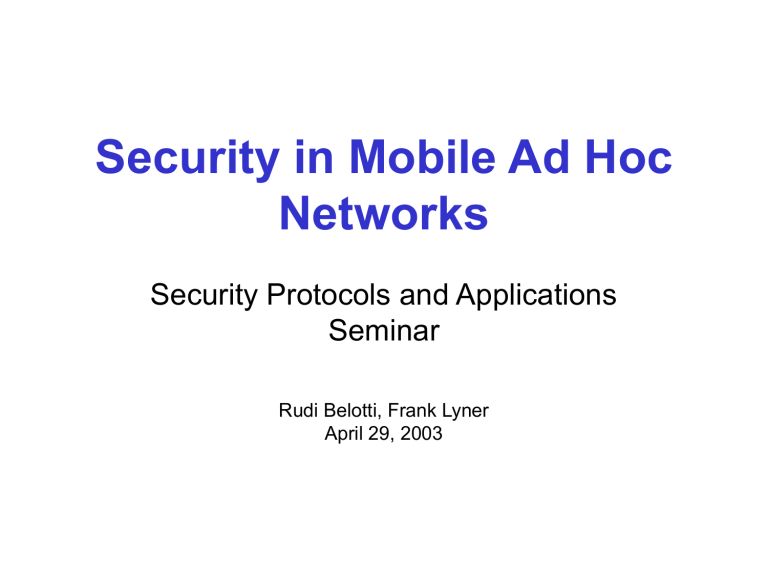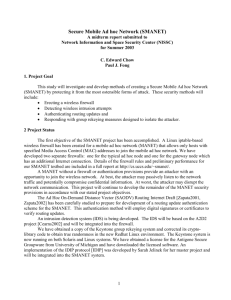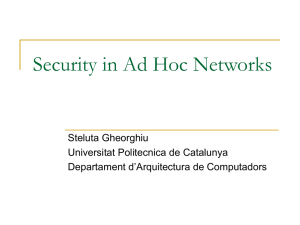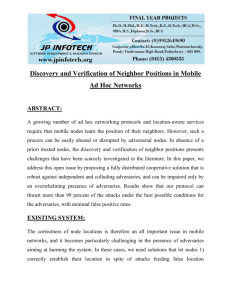Security in Mobile Ad Hoc Networks

Security in Mobile Ad Hoc
Networks
Security Protocols and Applications
Seminar
Rudi Belotti, Frank Lyner
April 29, 2003
Contents
• Basic introduction to ad hoc networks
• Basic Mechanisms (F. Lyner)
– Routing
– Physical location
• Security Mechanism (R. Belotti)
– Public Key infrastructure
– Key establishment
2
Introduction
• Definition of Mobile Ad Hoc Network
– Collection of mobile nodes that can dynamically form a network that does not rely on any infrastructure.
• Characteristics of the nodes
– Wireless
– Limited power and CPU resources
3
Characteristics and Constraints
• Limited Range
– Due to limited power supplies
– Each node acts also as router to relay packets
COLLABORATION
• Mobility
– Nodes can dynamically join and leave the network
– Routing information only valid for limited time.
• No (centralized) public key infrastructure
4
Security Goals
• Availability
– Very challenging due to all characteristics
• Confidentiality, Integrity, Authentication
– Usually require a public key infrastructure
– Security mechanisms must be distributed
5
Basic Mechanisms
• Basic Mechanism
– Services and/or guarantees that would usually be provided by the infrastructure
• Major Security Goal: Availability
– Nearly all attacks are DoS attacks
– Even more difficult to handle than in “normal” networks due to collaboration requirement, mobility and nature of communication channel
6
Physical
• Threat of capture and compromise
– Most scenarios of ad hoc networks include nodes without surveillance
• Attacks
– Theft, demolition, changes in environment
– Manipulation of hard-/software
• Counter measures
– Tamper resistant devices, very difficult for sensors
7
“Over the Air”
• Threats due to wireless communication
• Attacks
– Eavesdropping, jamming, spoofing, “message attacks”
– Sleep deprivation torture
• Counter measures
– First attacks are not specific to ad hoc networks, well researched in military context: frequency hopping, spread spectrum
8
Collaboration
• Every algorithm in ad hoc networking depends on some extents from the collaboration of the other nodes
• Main example: Routing Protocols
– Here: explaining the route discovery protocol
9
a
Route Discovery Protocol
• Used by DSR (Dynamic Source Routing)
• Simplified c f e abde
RREQ: Route Request
RREP: Route Reply d b
10
Route Discovery Protocol (2)
• Behavior in case of error
RERR: Route Error a c b f d e
11
Route Discovery Protocol (3)
• Great number of attacks possible by
– Not participating at all to save battery or partition the network
– Spamming the network with RREQ
– Changing routing information in RREP messages
– Constantly or never replying with RERR
– …
12
Solutions
• The CONFIDANT Protocol
– Idea: punish non collaborative/malicious nodes by non-forwarding their traffic
– Detection through “neighborhood watch”
– Building a distributed system of reputation
– Enable “re-socialization” through timeouts in the black list.
Sonja Buchegger, Jean-Yves Le Boudec: Nodes Bearing Grudges: Towards Routing Security, Fairness, and
Robustness in Mobile Ad Hoc Networks . In Proceedings of the Tenth Euromicro Workshop on Parallel,
Distributed and Network-based Processing, Canary Islands, Spain, January 2002
13
Solutions (2)
• Nuglets
– Idea: virtual currency to buy the collaboration
– Nuglets are attached to the message
– Each relaying node takes nuglets form the message which can use to buy the routing of its own message
– Nuglet module must be implemented in a tamper resistant hardware to avoid cheating
Jean-Pierre Hubaux, Levente Buttyan, Srdan Capkun: The Quest for Security in Mobile Ad Hoc Networks . In
Proceedings of the ACM Symposium on Mobile Ad Hoc Networking and Computing (MobiHOC), Long Beach, CA,
USA, October 2001
14
Solutions (3)
• Securing Routing Information
– Idea: share the routing information through a secure channel
– Requires Key Management and Security
Mechanisms
15
Security Mechanisms
• Most critical and complex issue:
Key Establishment
– Key agreement
– Key transport
• Asymmetric cryptography is appropriate for ad hoc networks to authenticate nodes
16
Asymmetric cryptography
• Each node has a public/private key pair
– For efficiency reasons and to limit power consumption, use asymmetric cryptography to exchange symmetric keys, then use them to secure communication
• Threat: man-in-the-middle
Alice
Charlie
Bob
C=E(K
UCharlie
,M) C=E(K
M=E -1 (K
RCharlie
,C)
UBob
,M)
17
Asymmetric cryptography
• How to authenticate the owner of a device?
• Classical solutions need a central trusted authority
– Not suited for ad hoc networks
18
Resurrecting Duckling
• Ducklings emerging from their eggs
– Recognize their mother as the first moving object emitting sound they see
• Similar approach for electronic devices
– Recognize the owner as the first entity that sends a private key
• If the owner changes?
– It should be possible to reinitialize the device
(resurrect it)
Frank Stajano, Ross J. Anderson: The Resurrecting Duckling: Security Issues for Ad Hoc Wireless Networks . In
Proceedings of Security Protocols Workshop, 1999
19
Threshold cryptography
• Emulate the central authentication authority by distributing it on several nodes acting as servers
• Private Key is divided into n shares s
1
, s
2
, ... s n
L. Zhou and Z. Haas: Securing Ad Hoc Networks . IEEE Network Magazine, vol. 13, no. 6, November/December 1999 20
Threshold cryptography (2)
• ( n , t+1 ) threshold cryptography configuration
• n servers, if t are compromised, it is still possible to perform the service
• E.g. (3, 2) threshold cryptography scheme
L. Zhou and Z. Haas: Securing Ad Hoc Networks . IEEE Network Magazine, vol. 13, no. 6, November/December 1999 21
Threshold cryptography (3)
• Threshold cryptography seems to be a very robust solution
• However it needs some nodes to assume special behaviour
• For instance it is appropriate for military applications
• Inadequate for civilian networks
– Users behave in a completely selfish way
22
Self-organized PKI
• Similar to PGP
• Certificate issued by users
– Bind public key to an identity
• Each user maintains a local certificate repository
– Certificates issued by itself
– Other certificates selected using some algorithms (Shortcut Hunter)
– Size of certificate repository is small compared to the total number of users in the system
23
Self-organized PKI (2)
• How it works
– u wants to verify the public key of v
– u and v merge their local certificate repositories
(subgraphs)
– u tries to find a certificate chain (path) from u to v in the merged repository v subgraph of u subgraph of v path from u to v
Jean-Pierre Hubaux, Levente Buttyan, Srdan Capkun: The Quest for Security in Mobile Ad Hoc Networks . In
Proceedings of the ACM Symposium on Mobile Ad Hoc Networking and Computing (MobiHOC), Long Beach, CA,
USA, October 2001
24 u
Self-organized PKI (3)
• Only probabilistic guarantee to find an appropriate certificate
• Security self-organized as the WWW?
– How can these mechanisms be put in place preventing their misuse?
25
Common context
• The use of symmetric cryptography is also possible
• For the set up of an ad hoc network in case of a conference
– Password could be written on a blackboard
• Idea: use another medium to exchange the keys
26
Conclusion
• Security in ad hoc networks is a very challenging issue
• Basic Mechanisms
– Difficult to force the nodes to collaborate
– No standard routing protocol yet
27
Conclusion (2)
• Because of their characteristics, ad hoc networks, are open especially to DoS attacks
• Classical security solutions are not suited for ad hoc networks
– Security services should be distributed
• Standard protocols?
– At the moment no universal solution
28








